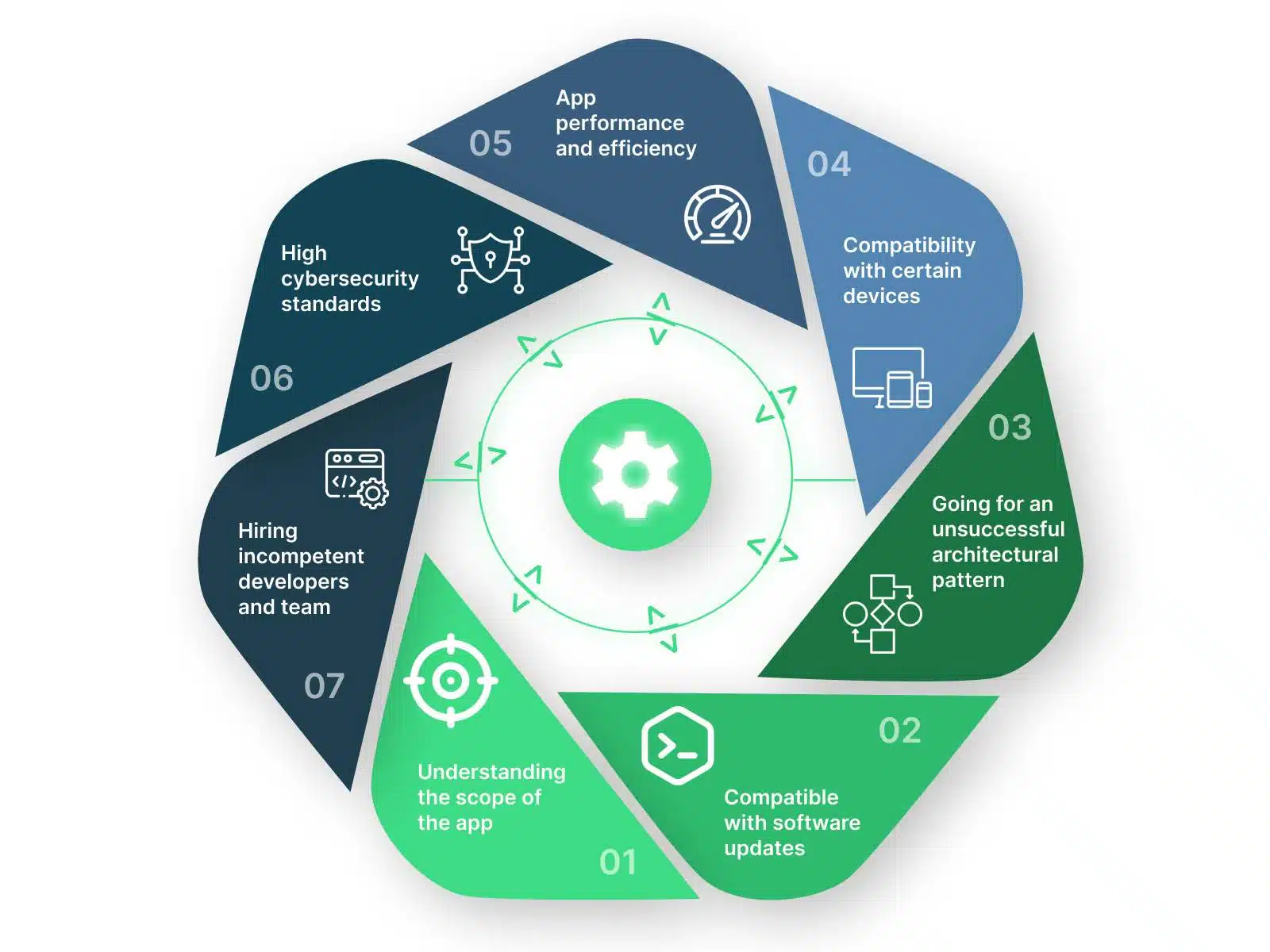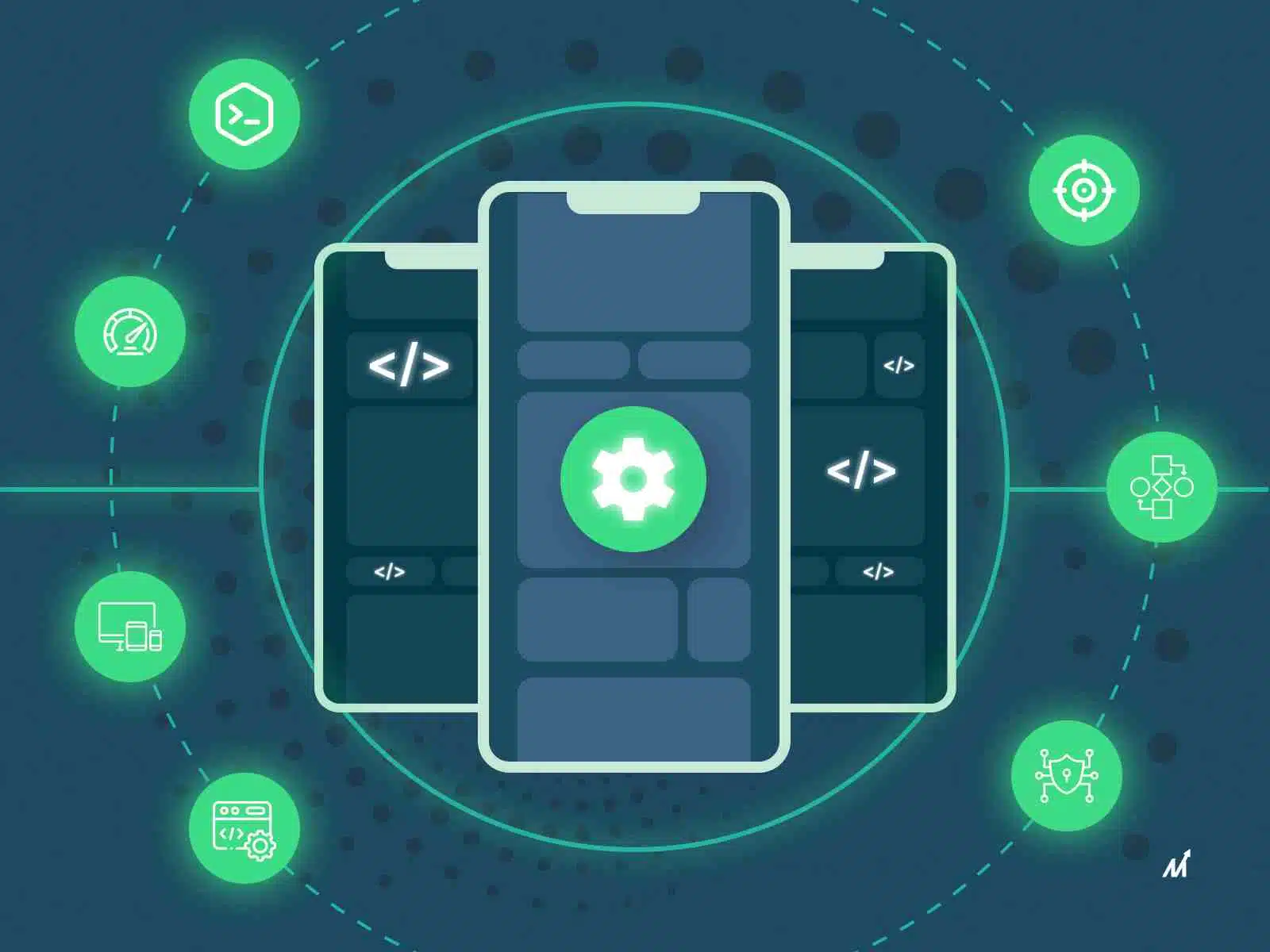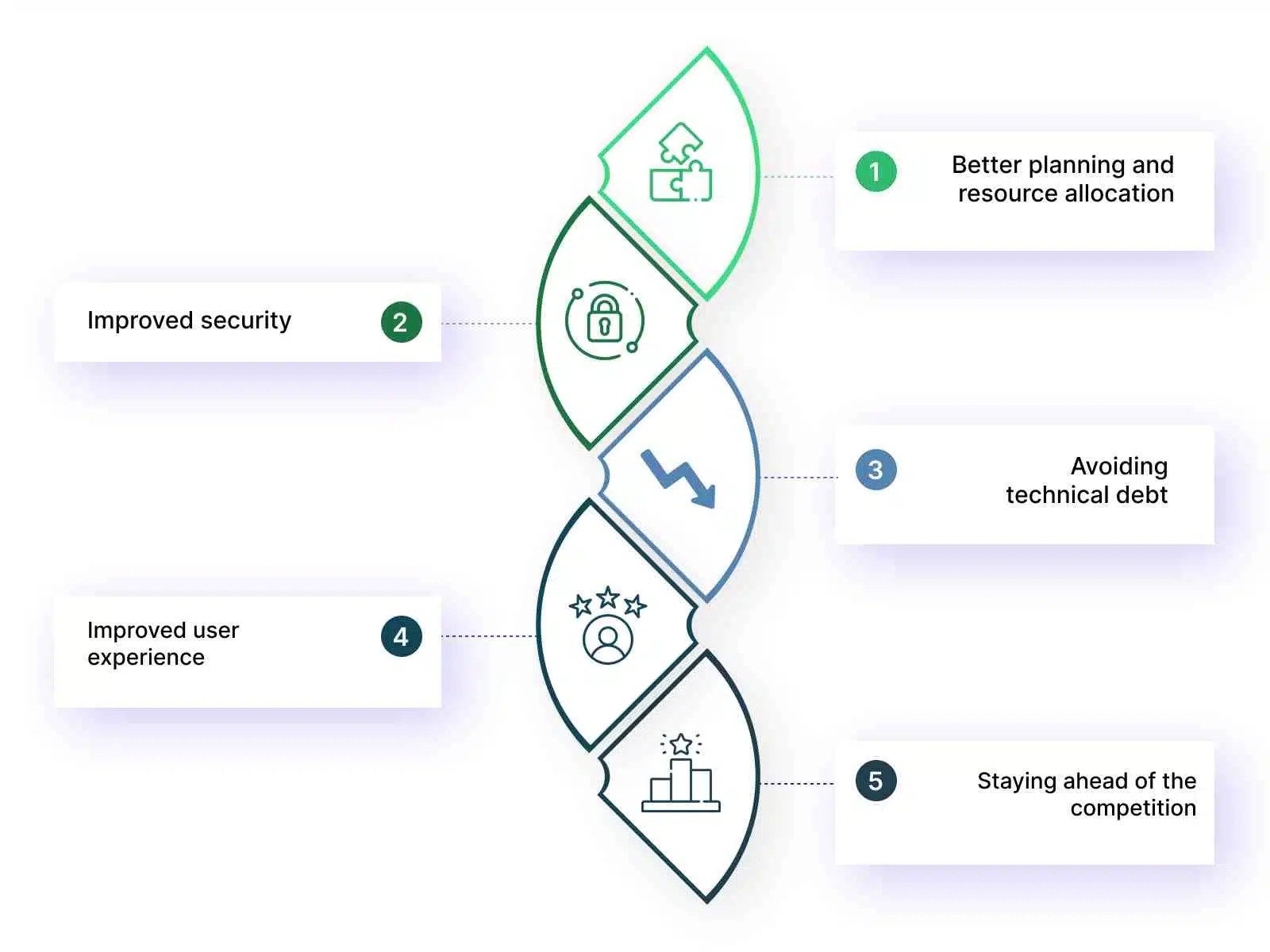Do you know that 56% of users uninstall apps within 7 days?
One of the primary concerns in the mobile application industry is the low retention rate, especially with so many competing apps readily available.
In the current digital era, developing mobile apps has become essential to businesses since it enables them to engage with their users and offer them convenient, high-quality services. Even so, there are challenges involved in the development process. App developers must overcome many mobile app challenges, from defining the app’s purpose and functionality to designing a user-friendly interface and testing the final product.
Furthermore, keeping up with the ever-evolving technological landscape and user expectations can be challenging. It is possible to overcome these challenges by planning carefully, developing competently, and striving to deliver the best user experience.
Top 7 mobile app development challenges
Many challenges occur while mobile app development. Among the most crucial are the following:

#1 Challenge: Understanding the scope of the app
First, do thorough research on your intended app if you don’t want to waste your time, effort, and money developing an app that no one will download.
One of the most complex challenges in developing mobile apps is comprehending the project’s scope. A thorough understanding of the project scope is crucial to avoid scope creep, which occurs when additional features are added, or the original plan is modified.
This extensive documentation will aid you and keep things simple for communication if you intend to develop an app through a mobile app developer.
What should you consider concerning your users?
- Who are you targeting?
- How do you envision your users utilizing the application?
- How do you intend to market your app?
While it may seem like a lot to think about and research, you will save a lot of time in the end. This will not only make it simpler for you to determine whether or not to proceed with developing your mobile application, but it will also make it easier for you to communicate with the app developers.
How to overcome this challenge?
Work with stakeholders to establish the project’s scope, conduct a feasibility study to evaluate the app’s possible impact and success, and develop a thorough project plan with precise deadlines and milestones. It is crucial to continuously assess and adjust the scope of the app to ensure it continues to serve the business’s and its customer’s goals.
#2 Challenge: Compatible with software updates
Maintaining compatibility with software updates is a critical but challenging aspect of mobile application development. Operating system updates can bring new features, improvements, and security fixes, but they can also cause compatibility issues with mobile apps. This can result in bugs, crashes, and other UX issues.
Third-party libraries and APIs also often rely on mobile apps, which may not be updated promptly. Another challenge is the compatibility with hardware updates, as the latest devices may have new features or specifications that the app needs to be compatible with.
Keeping the mobile application compatible with the latest software updates requires ongoing effort and resources, including regular mobile app testing and debugging, updating code and dependencies, and providing users with timely updates.
How to overcome this challenge?
A proactive approach and a solid testing and maintenance plan are required to overcome the challenges posed by software updates in mobile application development. Keeping track of the latest software updates and changes in operating systems and devices is crucial in ensuring the app remains compatible. App developers should also stay informed of updates to third-party libraries and APIs that the app relies on.
Regular testing and debugging can help identify compatibility issues and ensure that the app continues functioning properly with software updates.
It’s also essential to have a clear strategy in place for updating the app’s code and dependencies. This may involve using version control systems and keeping the app’s codebase up-to-date with the latest stable releases of dependencies.
#3 Challenge: Going for an unsuccessful architectural pattern
An architectural pattern refers to the structure and design of an application, including how it is organized, how data is processed, and how different components interact.
Choosing the right architectural pattern is crucial for the success of an app, as it can impact the app’s performance, scalability, and maintainability.
In mobile application development, choosing an architectural pattern that does not meet the app’s specific requirements is a major challenge. For example, a monolithic architecture may not best serve an app that requires high performance and scalability, which can become slow and unwieldy as the app grows.
Similarly, an app that requires frequent updates and changes may not be well-served by an architecture that is difficult to modify and maintain.
Another problem with using an unsuccessful architectural pattern is that it can lead to technical debt. Technical debt refers to the work that must be done to maintain and update an app over time. An unsuccessful architectural pattern can result in a codebase that is difficult to modify and maintain, making it more expensive and time-consuming to update and improve the app.
How to overcome this challenge?
Businesses should follow these steps to avoid developing an unsuccessful mobile app architectural pattern:
- Model-view-controller (MVC) architecture: MVC is a popular architectural pattern well-suited to developing mobile apps. It separates the user interface, data, and control logic into separate components, making it easier to manage and maintain the app as it grows.
- Model-view-viewmodel (MVVM) architecture: MVVM is a variation of the MVC pattern explicitly designed for use with modern user interfaces, such as those found in mobile apps. It allows app developers to create a clean separation between the user interface and the data and control logic, making updating and maintaining the app easier.
- Service-oriented architecture (SOA): SOA is an architecture that uses services to communicate between components, allowing for a flexible and scalable approach to mobile development. This architecture is well-suited to developing large-scale apps that must communicate with multiple back-end systems and services.
App developers can use several technical solutions to overcome the challenge of going for an unsuccessful architectural pattern in mobile app development. MVC, MVVM, Microservices, SOA, and Event-Driven architectures are examples of these architectures, each with its strengths and weaknesses.
#4 Challenge: Compatibility with certain devices
Compatibility with certain devices is a major challenge in mobile app development. With the plethora of mobile devices available in the market, ranging from different screen sizes and resolutions to operating systems and hardware specifications, it becomes imperative for a mobile app to be compatible with all of them to reach a wider audience.
Developing an app that runs seamlessly on all devices is complex and requires careful planning, design, and testing. The user interface must be intuitive, user-friendly, and aesthetically pleasing, regardless of the mobile device it is running on. The aspect ratio, screen size, and resolution must be considered while designing the user interface.
Moreover, different operating systems, such as iOS and Android, have other programming languages, design guidelines, and technical requirements, making it challenging for app developers to ensure compatibility with both.
How to overcome this challenge?
Mobile app developers can overcome the challenges of device compatibility and display dimensions by utilizing hybrid app development tools, device emulators, responsive design methodologies, platform-specific development, and routine testing. These solutions can aid in ensuring that an app runs without a hitch on many devices and offers an excellent UX on various display sizes.
#5 Challenge: App performance and efficiency
Users have harsh standards for performance. Any home screen will not provide a permanent spot for an app that loads slowly or fails frequently. You can never be certain of the mobile platform or device your customers will choose to use your app on.
Mobile devices often have limited bandwidth and are subject to interruptions and fluctuations in network connectivity, which can impact the performance of mobile applications that rely on data from the internet. Developers must account for these issues and design their apps to minimize the impact of network latency.
There are many native conditions app developers must consider, including outdated hardware and operating systems. It is impossible to consider every factor, and time is running out before the consumer quits up and switches to a competitor app.
How to overcome this challenge?
To overcome these performance challenges, developers must take a comprehensive approach that involves careful planning, thorough testing, and ongoing optimization. This may include using tools to monitor and diagnose performance issues, implementing caching and data compression techniques to reduce the amount of data transmitted over the network, and optimizing the use of resources like memory and storage.
By taking these steps, developers can ensure that their apps are fast, responsive, and efficient, delivering an optimal UX.
#6 Challenge: High cybersecurity standards
A business app often contains sensitive data that needs to be protected. As a result, data protection is a top priority whenever a developer begins creating a mobile app.
Cyberattacks are becoming prevalent and have been a significant security threat to businesses.
High cybersecurity standards are a critical concern in mobile app development. Mobile devices are increasingly being used to the app store and access sensitive personal and financial information.
The following are some of the specific cybersecurity challenges that developers must consider when building mobile apps:
- Data encryption
- Malware
- Network attacks
- Vulnerabilities
How to overcome this challenge?
To overcome the challenges of ensuring high cybersecurity standards in mobile app development, developers must adopt a multi-faceted approach that includes the following steps:
- Secure coding practices: App developers must implement secure coding practices, like input validation and error handling, to prevent the introduction of vulnerabilities. They should also follow established security standards, such as OWASP, to ensure that their apps are secure.
- Secure authentication: Mobile apps must include secure authentication mechanisms, such as strong passwords or biometric authentication, to prevent unauthorized access. Developers should implement secure authentication mechanisms that meet industry standards and are easy for users to use.
- Anti-malware measures: Mobile devices are vulnerable to malware, which can compromise the security of apps and the data they contain. Developers should implement anti-malware measures, such as using anti-virus software, to protect against malware threats.
By taking these steps, developers can ensure that their mobile apps meet high cybersecurity standards and deliver the security and privacy that users demand. It’s essential for developers to stay informed and up-to-date on the latest security threats and best practices and to regularly review and update their security measures to ensure that their apps remain secure over time.
#7 Challenge: Hiring incompetent developers and team
Hiring inappropriate developers and team members can significantly challenge mobile app development. An app project’s success depends on the skills and expertise of the developers and team members involved in the project. Inexperienced developers may not have the necessary technical skills, leading to delays in the project and a subpar product.
Additionally, developers unfamiliar with the development process, methodologies, and tools can cause disruptions and negatively impact the overall quality of the project. Incompatible communication and collaboration styles among team members can also create friction and slow development.
A lack of commitment can also be a concern with inappropriate hires, leading to missed deadlines and poor project outcomes.
How to overcome this challenge?
To overcome these challenges, you must do your due diligence and carefully evaluate potential partners using a combination of technical and non-technical criteria. They should also set clear project goals, budgets, and schedules and communicate these to potential partners to ensure they have a shared understanding of the project requirements. By taking these steps, you can choose the right development partner and ensure the success of their mobile app project.
Why is it important to know about mobile app development challenges?
Several factors make it crucial to be aware of the challenges involved in developing mobile applications, including:
- Better planning and resource allocation: You may devote resources to address mobile app development challenges by planning for them.
- Improved security: You can take the necessary actions to secure your app and protect user data if you know the security problems and potential vulnerabilities that may arise during mobile app development. As part of this, secure APIs must be used, sensitive data must be encrypted, and vulnerabilities must be tested.
- Avoiding technical debt: Understanding technical difficulties, such as performance and scalability problems, enables you to make well-informed decisions that prevent the accumulation of technical debt, which can ultimately harm the success of your service.
- Improved user experience: You may design apps accessible to a broader range of users and provide a better overall UX by being aware of compatibility and accessibility issues. This includes considerations such as device compatibility, screen size, and accessibility.
- Staying ahead of the competition: By being aware of the challenges in mobile app development and taking proactive measures to overcome them, you can stay one step forward. This entails remaining current with the newest technology, trends, and best practices for developing mobile applications.
How to tackle most of the mobile app development challenges even before they arise?
Certainly, let’s simplify while retaining the essential insights for businesses and enterprises engaged in mobile app development.
1. Start with detailed market research
The first step in developing a successful app is to understand the market. Knowing who the competitors are and what the target audience wants can help define the app’s features. It helps to start with questions like: “Who will use this app?” and “What problem will it solve?” Getting these answers can also help in predicting how many people might download the app, making it easier to decide if the project will be profitable.
2. Design for all screen sizes
When it comes to design, flexibility is key. A design that adjusts itself to fit any screen size is known as a responsive design. This ensures that the app looks good on all devices, from smartphones to tablets. For an even better user experience, use alternative layouts so the app automatically rearranges itself to make the best use of available screen space.
4. Think about security early on
Security should never be an afterthought. Different regions have different regulations and it’s important to know these well in advance. Most platforms provide Software Development Kits (SDKs) with guidelines on how to make an app secure. Compliance with existing laws and continual monitoring for updates to these laws is vital. It’s also essential to plan how to keep the app secure as it evolves, to protect user data and maintain trust.
5. Plan features based on audience needs
The tools and frameworks used in app development should align with what the target audience needs. Research will again play a big role here. If the app is for a global audience, consider localization features. If it’s for a specialized industry, think about integrations or functionalities that would be valuable to those specific users.
6. Start small with a Minimal Viable Product (MVP)
One effective approach is to initially roll out a Minimal Viable Product (MVP), an app with just the bare minimum features required for it to be functional. This is not only cost-effective but also serves as a litmus test for market receptivity. It allows for real-world testing of the app’s core functionalities, while also providing valuable user feedback for future iterations.
By incorporating these steps into the mobile app development process, enterprises stand a significantly higher chance of launching an app that is well-received by its target audience, compliant with regulations, and flexible across device platforms. It’s a blend of meticulous planning, technical execution, and an ongoing commitment to iterative improvement.
How can Markovate help in overcoming mobile app development challenges?
Markovate can assist in overcoming challenges in mobile app development by:
- Before beginning the development process, we perform extensive study and preparation to identify potential obstacles and come up with solutions.
- Our team uses an agile development process. It enables adaptable and iterative development, making it simpler to deal with problems as they arise and adjust to changes.
- Our team works closely with our clients to understand their requirements to develop an app that meets their expectations.
- Our team regularly tests and refines the app throughout development to find and fix any problems.
- We use thorough quality assurance and testing procedures to find and fix bugs or issues before the app releases.
- To ensure the app is dependable, scalable, and able to handle users, our team builds a solid and secure architecture.
- Frequently, we communicate with clients to update them on progress, address issues, and ensure the app meets their expectations.
As a mobile app development company, we create successful solutions from bright ideas by combining innovative thinking with excellent execution. Our track record of developing over 200+ mobile apps allows us to provide an accurate strategy to overcome all mobile app development challenges. Learn more about our mobile app development services.
Feel free to contact us if you need any further assistance.
Commonly asked questions about mobile app development challenges
1. What are the top app designing challenges?
The significant challenges in app design are:
- Design compatibility issues: You can test compatibility to ensure your app runs properly on all associated devices and platforms.
- Complicating the user interface: To make it easier for app users to browse the mobile app, try to streamline the user interface and ensure you only add the necessary functions.
- Design inconsistencies: You should incorporate other design components from your brand to ensure that the designs are cohesive.
2. What is the testing challenge in mobile app development?
Many devices for Android and iOS app development have unique custom settings to perform in various ways.
For the developers, it becomes challenging to support all current devices. Testers should be prepared for some issues to show up. Testing problems can, however, be resolved with expertise and tech stacks.
3. What are the three 3 components of mobile computing?
The term “mobile computing” refers to combining three technologies (a handheld computing device, connecting technology, and a centralized information system). Each has its performance requirements, associated costs, and hazards.









